McVeillance:
How McDonaldized surveillance creates a monopoly on sight that chills AR and smartphone development
Steve Mann, 2012, 1010 (October 10)"Surveillance" is a French word that means "to watch from above" or "to watch over". The closest English word is "oversight". Surveillance (oversight) means, quite literally, that those on top are watching those underneath.
What happens when surveillance becomes a monopoly that tries to extinguish other forms of sight like "sousveillance" (undersight)?
For example, 101 days ago, on July 1st, 2012, I was physically assaulted by three McDonalds employees because I was wearing Glass ("Digital Eye Glass" seeing aid). And they admitted to enforcing laws that don't even exist (link) ---- laws that their own surveillance cameras would violate if they did exist!
More and more people are using cameras as seeing aids, whether to photograph a menu and magnify the text, or to use a smartphone with optical character recognition to translate foreign text to their own language, or to read 2d barcodes on products. However, Penny Sheldon, a travel agent from Boise, Id., was also physically assaulted by McDonalds staff in Paris, France, because she photographed their menu (link).
Contradictions like these abound in many retail establishments that prohibit cameras while they also use 2-d barcodes that require people to use cameras to read them:
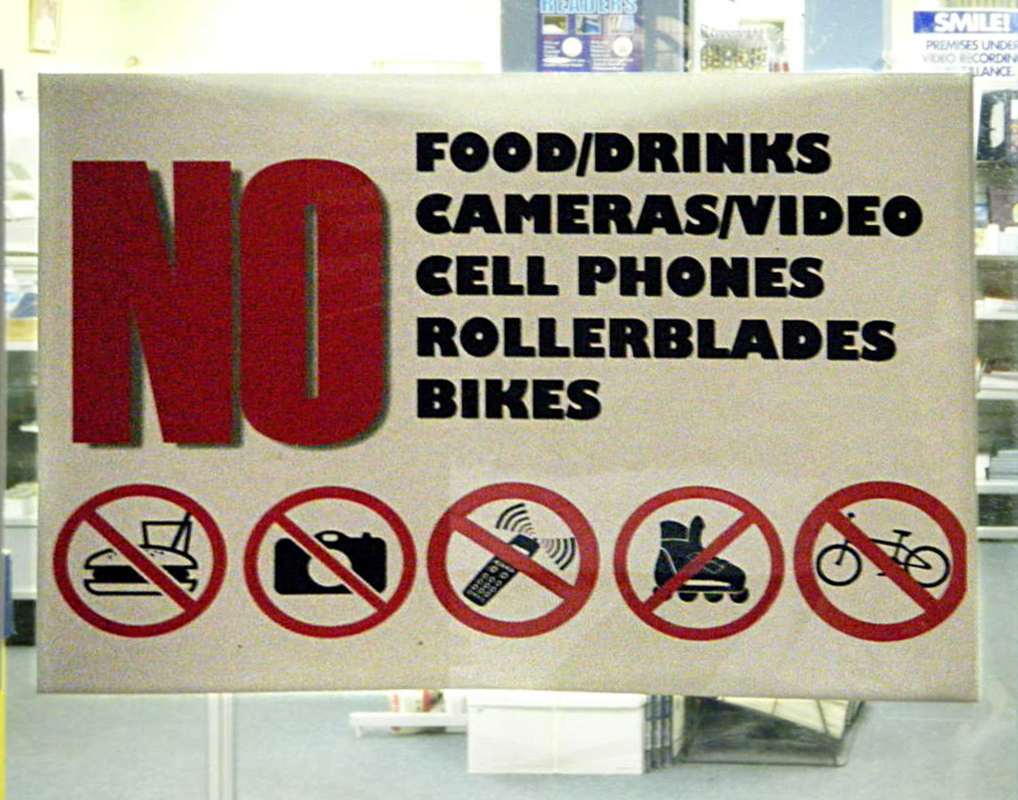
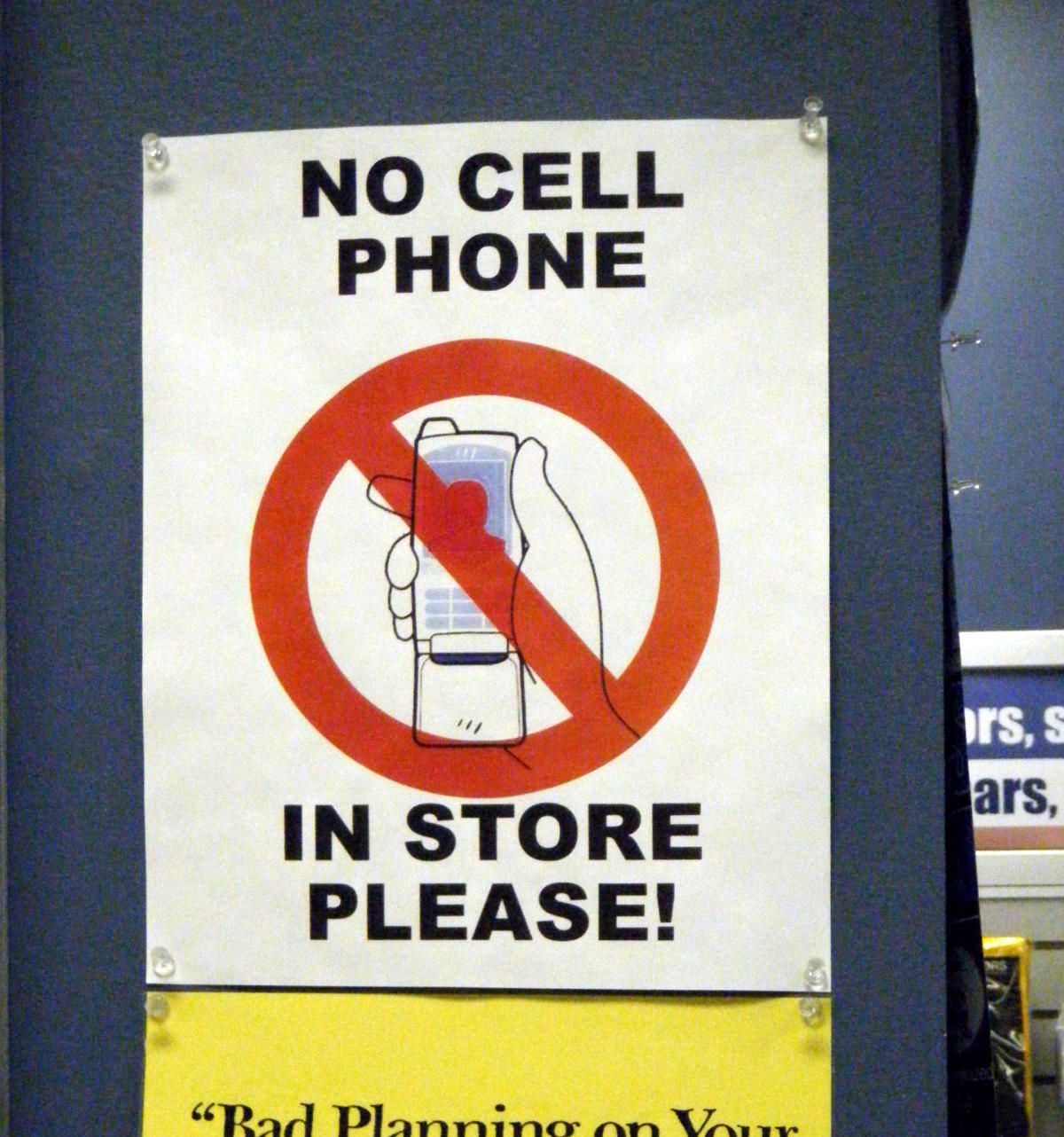
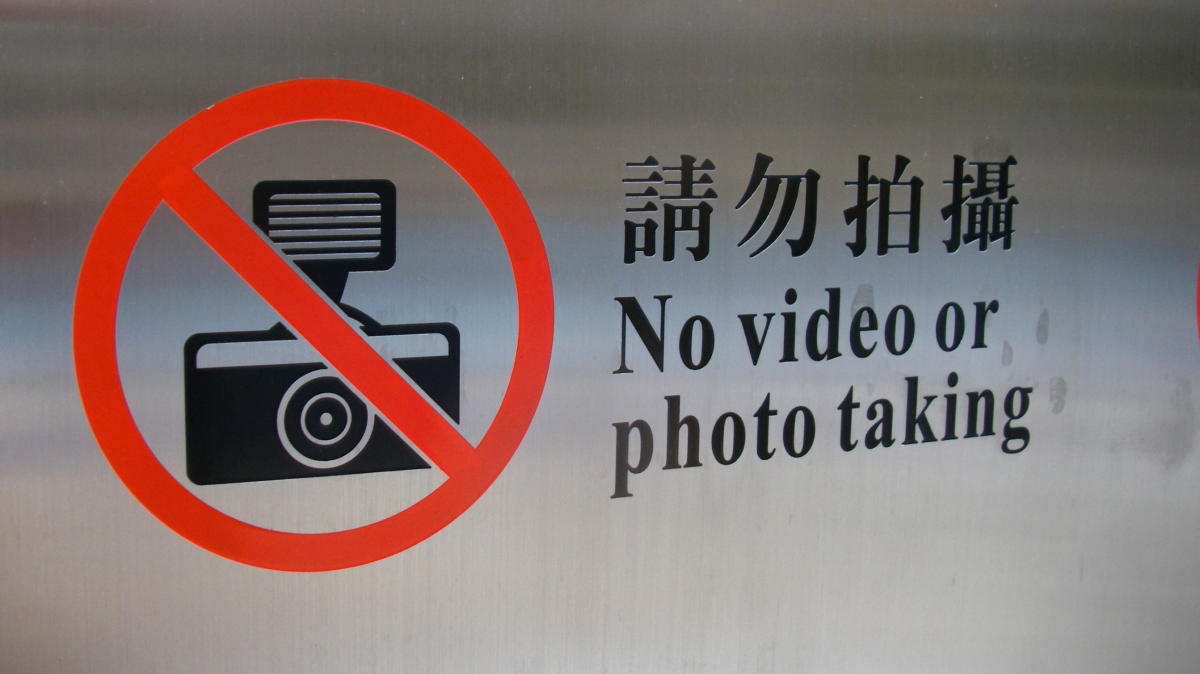
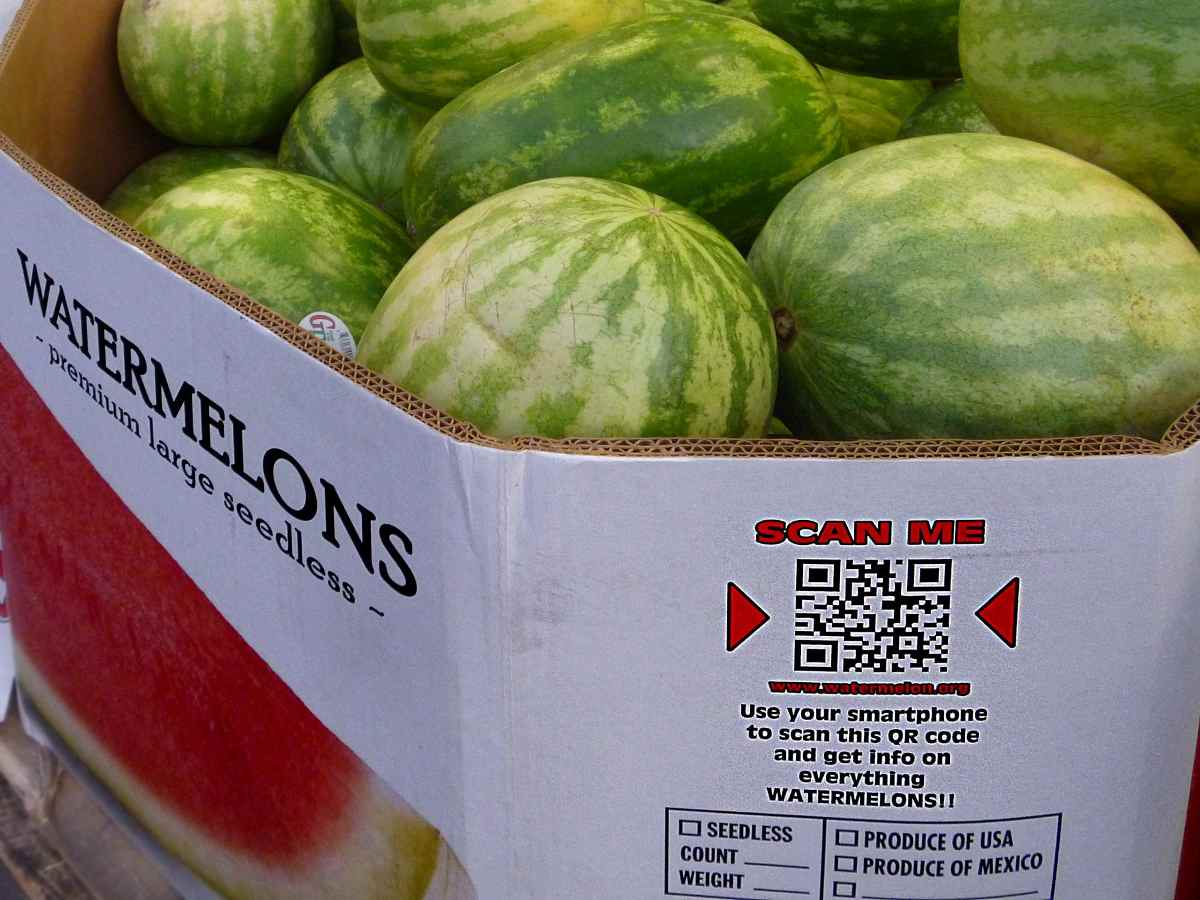
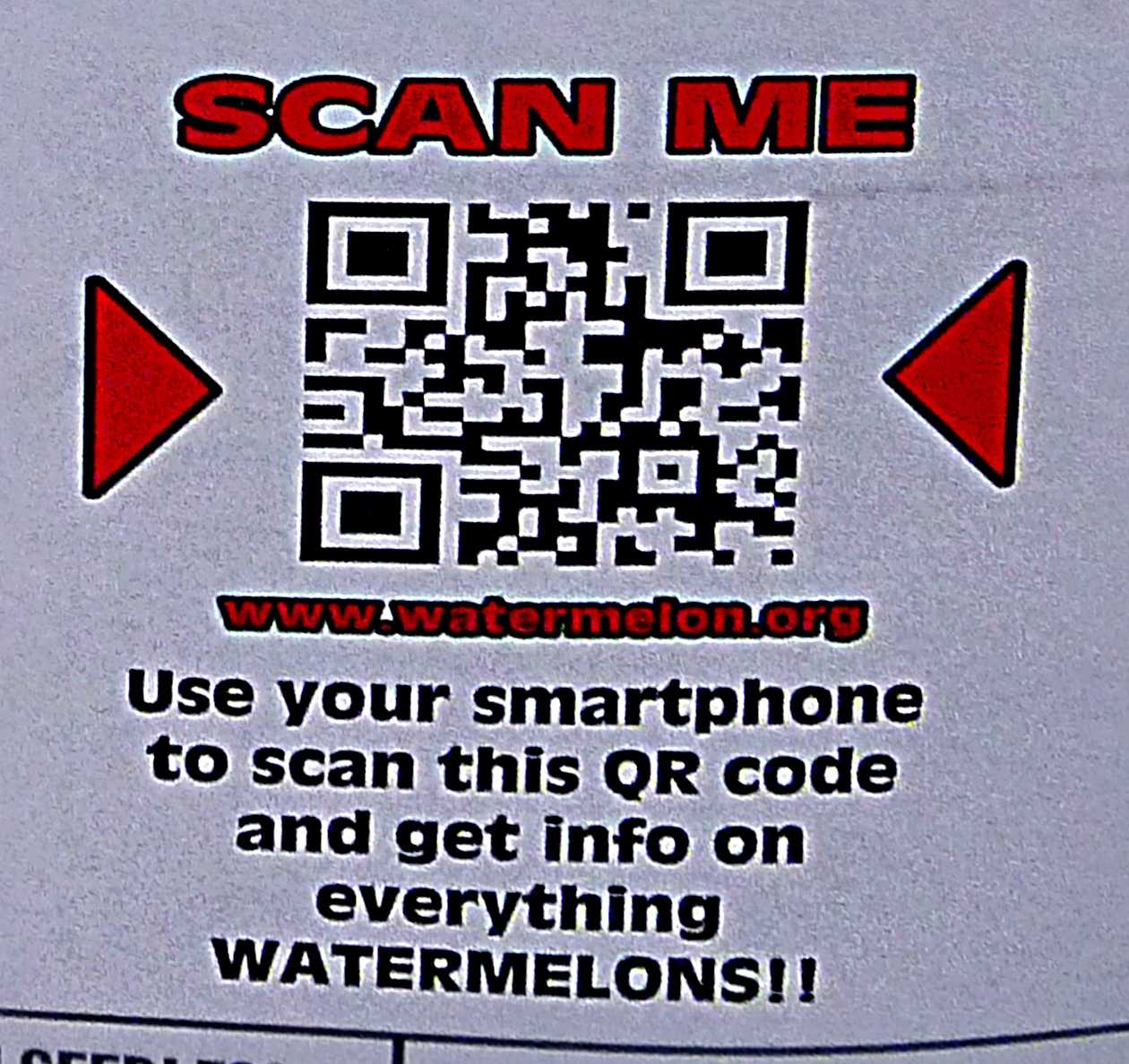
(Use your camera to scan these watermelons ... break the store rule prohibiting cameras)
Business establishments, like McDonalds, are also heavy users of surveillance cameras, many of which are hidden and secretly record both customers and employees.
McVeillance
George Ritzer coined the term "McDonaldization" to mean "The process by which the principles of the fast-food restaurant are coming to dominate more sectors of our society."Imagine a process that not only dominates most sectors of our society, but also extinguishes alternate viewpoints. In describing this much more pervasive force, I coin the word "McVeillance" in reference to "The process by which the principles of surveillance are coming to dominate sight itself."(!)
"McVeillance" is not merely the mass-production of surveillance, but also its one-sided sight: watching everyone while forbidding them from watching back.
Here's a definition:
McVeillance is the installation or using of surveillance cameras while simultaneously prohibiting people from having or using their own cameras, hand-held magnifiers, smartphones, or the like.
More precisely, McVeillance is the ratio of surveillance to sousveillance.
If there are eight surveillance cameras in a restaurant and only two customers have cameras then the McVeillance equals eight divided by two which is four, i.e. there are four times as many surveillance cameras as their are sousveillance cameras.
McVeillance can thus be an objective measure or fact, irrespective of the good or bad purposes to which the surveillance or sousveillance may be applied. Sight can be used for many purposes, both useful and harmful. But it should not be McDonalds staff that are the arbiters and permitters of sight. Nor should it be the role of government to be "thought police" and determine what we are allowed to see and not see or remember.
As a memory aid for an Alzheimers patient, or a seeing aid for AR, a camera for personal use (i.e. not distributing the images to others) should always be considered fair use.
But whether or not you agree with this viewpoint, McVeillance can still be a useful construct with which to argue for or against this viewpoint.
As an equation, McVeillance, M, equals Surveillance, S, divided by sousveillance:
| M = | S s |
A graphical depiction of this equation appears below:
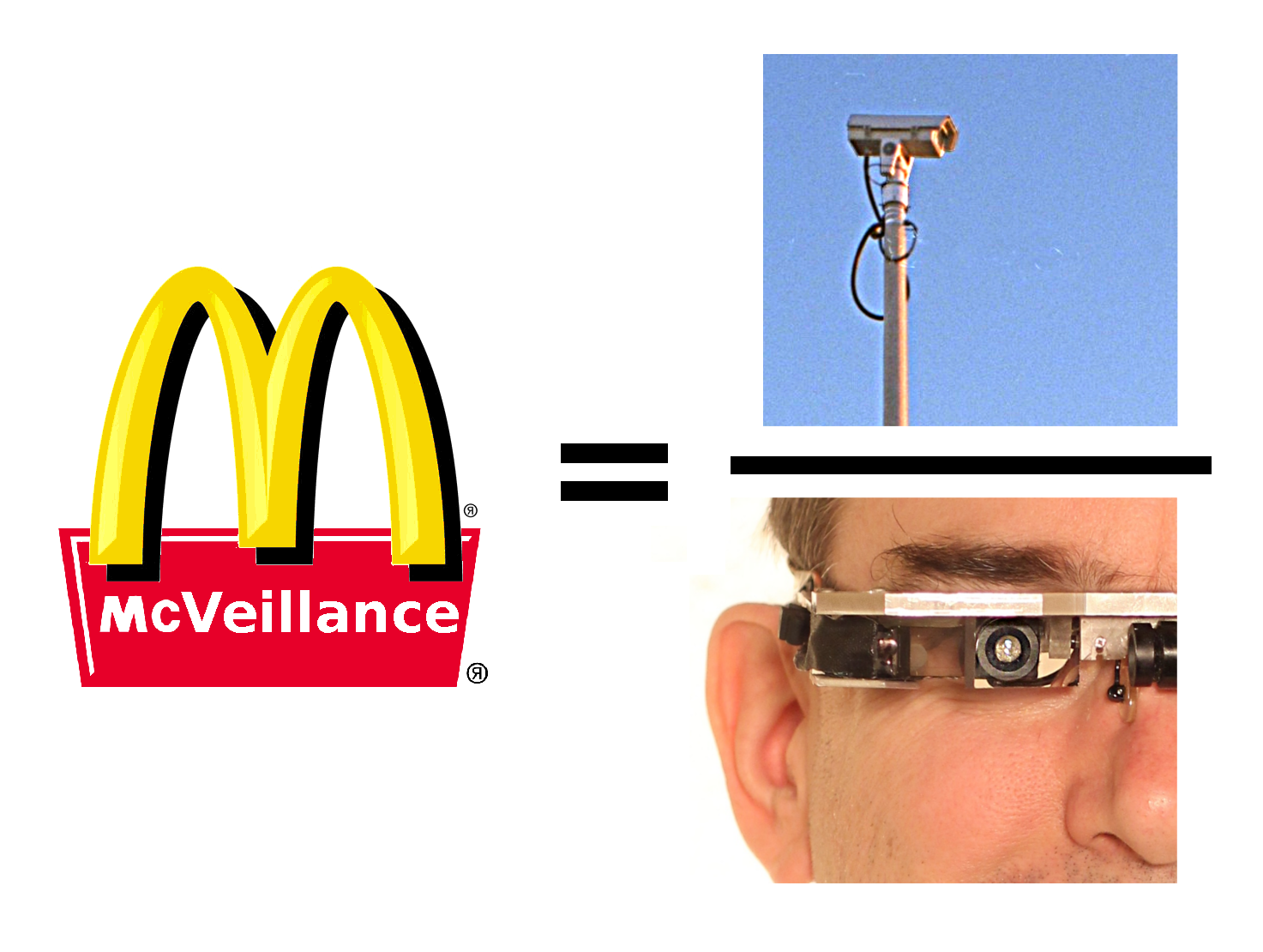
Use of the McDonalds symbol in satire is fair use, but if the reader prefers something less blatant, here it is replaced by something my 5-year old made (link).
Surveillance/Sousveillance
"Surveillance" is a French word that means "to watch from above", taken from the word "veiller" meaning "to watch" and "sur" meaning "above". A direct translation of the French word "surveillance" into the nearest English word would be the word "oversight".Examples of surveillance include police watching over citizens (citywide surveillance cameras as well as red-light cameras, traffic laws, etc.), and shopkeepers watching over shoppers. Surveillance suggests a general socio-political and economic "oversight".
More recently computer vision has entered the realm of surveillance, with such innovations as automatic red-light cameras, as well as energy management. I predict that soon there will be a camera in almost every streetlight (http://intellistreets.com/) and ultimately a camera in every light fixture (http://www.lsgc.com/pixelview/) for energy-management (to meet rising costs of electricity by dimming down the lights when nobody's around or needs them).
Thus the "eye-in-the-sky" ("God's-Eye View") has such a wide variety of purposes and promises (green-technology, public safety) to "save energy, save lives, and "save the planet", that surveillance is for the most part unstoppable, i.e. a fact-of-life. Surveillance has crept into all facets of our lives, including surveillance cameras in washrooms and locker rooms ("Cameras can stay in Talisman's locker room, says commissioner" http://www.cbc.ca/news/canada/calgary/story/2007/03/22/talisman-privacy.html) and the modern automatic flush toilets, faucets, and sensor-operated showers are starting to use more sophisticated camera-based computer-vision technologies (e.g. U.S. Patent 5828793).
Although there is some degree of "privacy" and "policy" to safeguard some of the surveillance data, there is also a potential conflict-of-interest in that those on the higher "rungs" of the social "ladder of life" (e.g. governments and large corporations) are often the ones who both conduct the surveillance as well as control, make, and enforce the policies that govern it.
Much of the surveillance is done in secret (the security profession itself is also very secretive) and cameras are often hidden behind ceiling domes of wine-dark opacity, or concealed in a variety of other ways (completely hidden in light fixtures, or integrated into signage, etc.).
There are people opposed to surveillance, and others in favour of it. Many of the conferences, symposia, and academic programs on surveillance and surveillance studies view surveillance as this one-dimensional axis: a tradeoff between security and safety (more surveillance) and privacy (less surveillance), as illustrated below:

Sousveillance (the opposite of surveillance)
If you or I try to question surveillance, we're told "if you have nothing to hide you should have nothing to fear", as if to imply that only criminals are afraid of cameras.But try photographing a policeman in a public place. Though perfectly legal, you might cause the policeman to break the law because he might smash your camera or become violent. (various references, e.g. affirming the right of citizens to photograph the police).
The simple act of photographing a policeman tells us that "veillance" is not merely a one-dimensional space.
"Sousveillance" is a French word that means the opposite of "surveillance". In French, "sous" means "below", thus "sousveillance" means "to watch from below". A direct and literal English translation would be the word "undersight". Whereas surveillance is very hierarchical, structured, bureaucratic, and mechanized, sousveillance is more rhizomic (like roots that grow horizontally rather than vertically) and human, like social networking.
Sousveillance can take many forms, and need not necessarily imply a 20th Century "us versus them" confrontation of citizens photographing police or shoppers photographing shopkeepers. For example, many people carry a camera (perhaps as part of a smartphone) to document their daily lives, and to help them see and remember things better.
For example, many people use a camera as a hand-held magnifier to help them read small print, or to "zoom in" on signs, such as restaruant menus. With the growing population of the elderly, and those with failing eyesight, the camera represents a useful seeing aid, the digital image often being sharper and clearer than that of bifocals or akward compound-lens eyewear.
Moreover the camera can do other things like translate a sign to another language (e.g. a smartphone can translate the menu in a French McDonalds to English automatically).
Unfortunately the same business establishments that are quick to embrace surveillance (e.g. to outfit their business establishment with a large number of surveillance cameras to capture audiovisual recordings of their employees and customers) are often not so open to sousveillance.
Sousveillance is not counter-surveillance. A person can be in favour of both surveillance and sousveillance, for example. Such a person is simply in favour of more veillance (of both kinds).
The four veillances and their eight points
More generally, we see that veillance is no longer a one-dimensional axis of surveillance versus anti-surveillance. Consider the diagram below: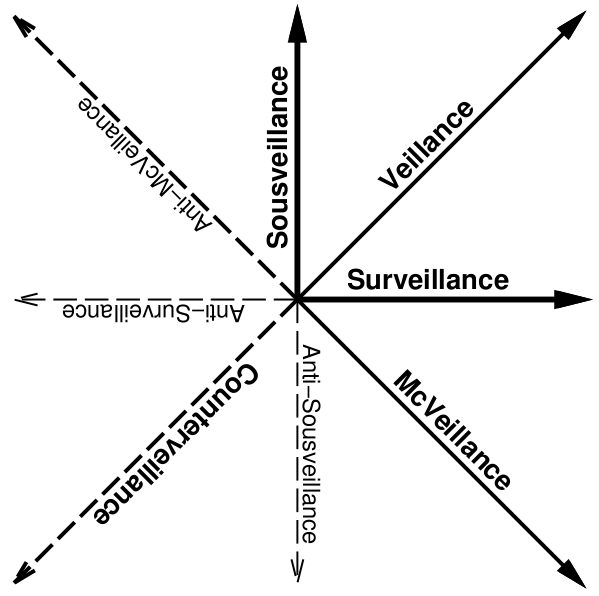 .
.
Surveillance and sousveillance are orthogonal (at right angles to one another), i.e. each can, in principle be increased or decreased independently of the other.
Veillance is the vector sum of surveillance and sousveillance. Veillance is an agnostic form of seeing, e.g. perhaps simply the total number of cameras (irrespective of whether they're surveillance cameras on the ceiling or hand-held or wearable cameras operated by individuals).
Counterveillance is the opposition to these cameras (an opposition to both surveillance and sousveillance). The center of the diagram is the origin (zero). Can we have a negative number of cameras? Yes, I believe we can! In some sense McDonalds destroyed my camera, so they owe me a new one, just as someone who borrows (or steals) money, owes it back. If you borrow something and owe it, that's like a negative number. In this sense, McVeillance is the linear combination of surveillance with anti-sousveillance (negative sousveillance). They've installed some surveillance cameras and they've destroyed some sousveillance cameras and therefore "owe" some people, or at least me, some (or at least one) sousveillance camera.
As an equation we now have:
McVeillance = Survellance - Sousveillance
where we consider these axes as logarithmic if we wish to be consistent with the previous equation that defined McVeillance as a ratio rather than a difference.
Another possible direction on the veillance compass is "Anti-McVeillance". I'm not so violent as to wear a camera into McDonalds while also vandalizing their surveillance cameras, but that would be an example of sousveillance combined with anti-surveillance. This direction of the veillance compass I will call "Anti-McVeillance".
A society with oversight-only is an oversight on our part
It would be a gross oversight on our part to construct a society without undersight. To have a survellance-only society is to have a society with inherent and potential conflicts of interest. Consider the example of installing surveillance cameras in only the East side of town (see below).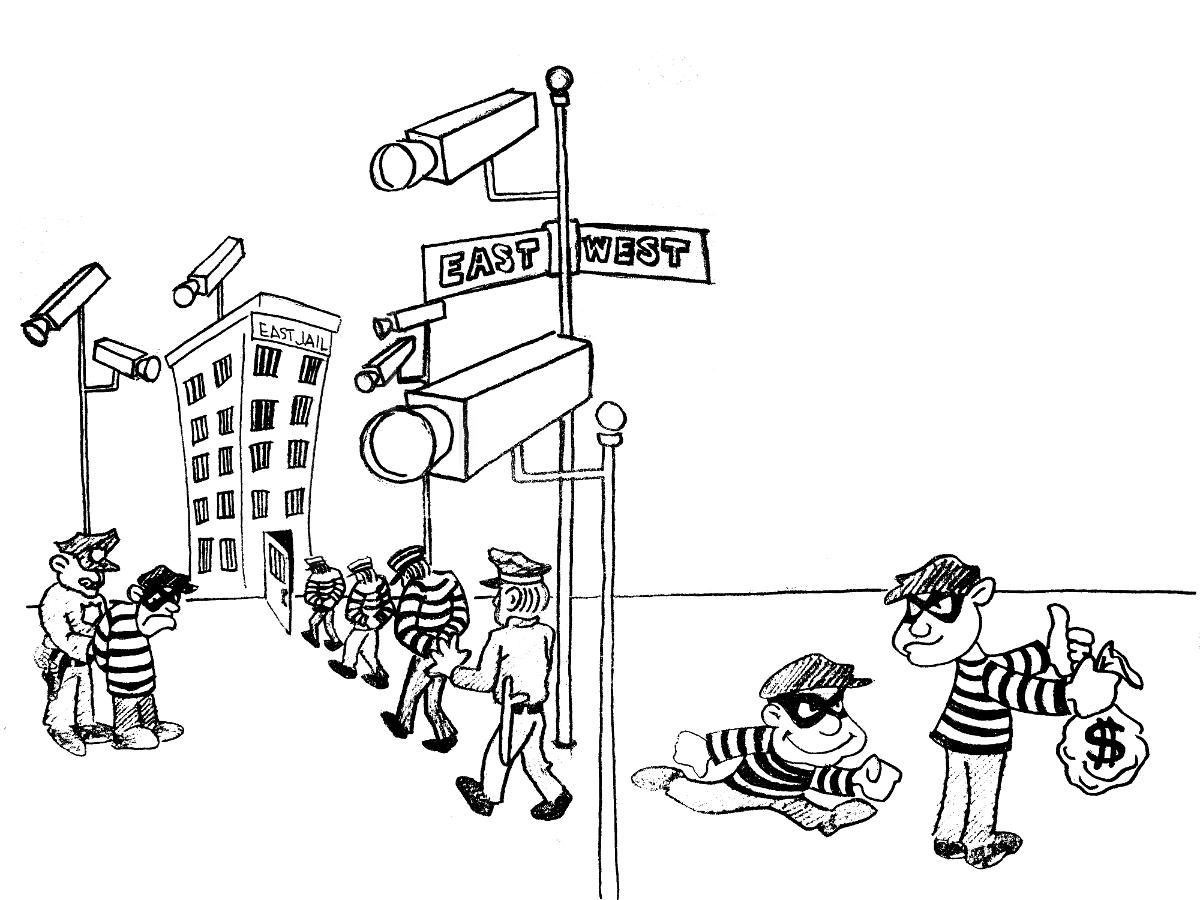
This could cause a Westward shift in crime's equilibrium, where some criminals actually move West, or where crimes move West by being stopped ("extinguished") on the east side, and and re-born (as new crimes) in the West-End, due to the greater relative (compared to the East) opportunities for crime there.
Can surveillance cause corruption?
Consider the case where surveillance cameras are also placed in the West-End, i.e. where cameras are everywhere. Installing surveillance cameras everywhere means that police are watching citizens, shopkeepers are watching shoppers, taxicab drivers are watching passengers, etc.. Thus, those on the bottommost rung of the social hierarchy are under close scrutiny, whereas those on the next rung, e.g. police, shopkeepers, and taxicab drivers, may escape some of this scrutiny.
With surveillance to the East and West (and everywhere else), crime could actually be driven Upward, from a lower rung of the ladder of power and political hiearchy, to become corruption at the higher rungs of this ladder.
In this example, it is not that over-sight (even in the panoptic sense) necessarly results in corruption, but that surveillance provides the opportuntities, precisely because of the power asymmetries built into surveillance systems, for corruption. Thus surveillance can cause "movement" of low-level street crimes up the proverbial ladder, to emerge as higher-level corruption, as illustrated below:
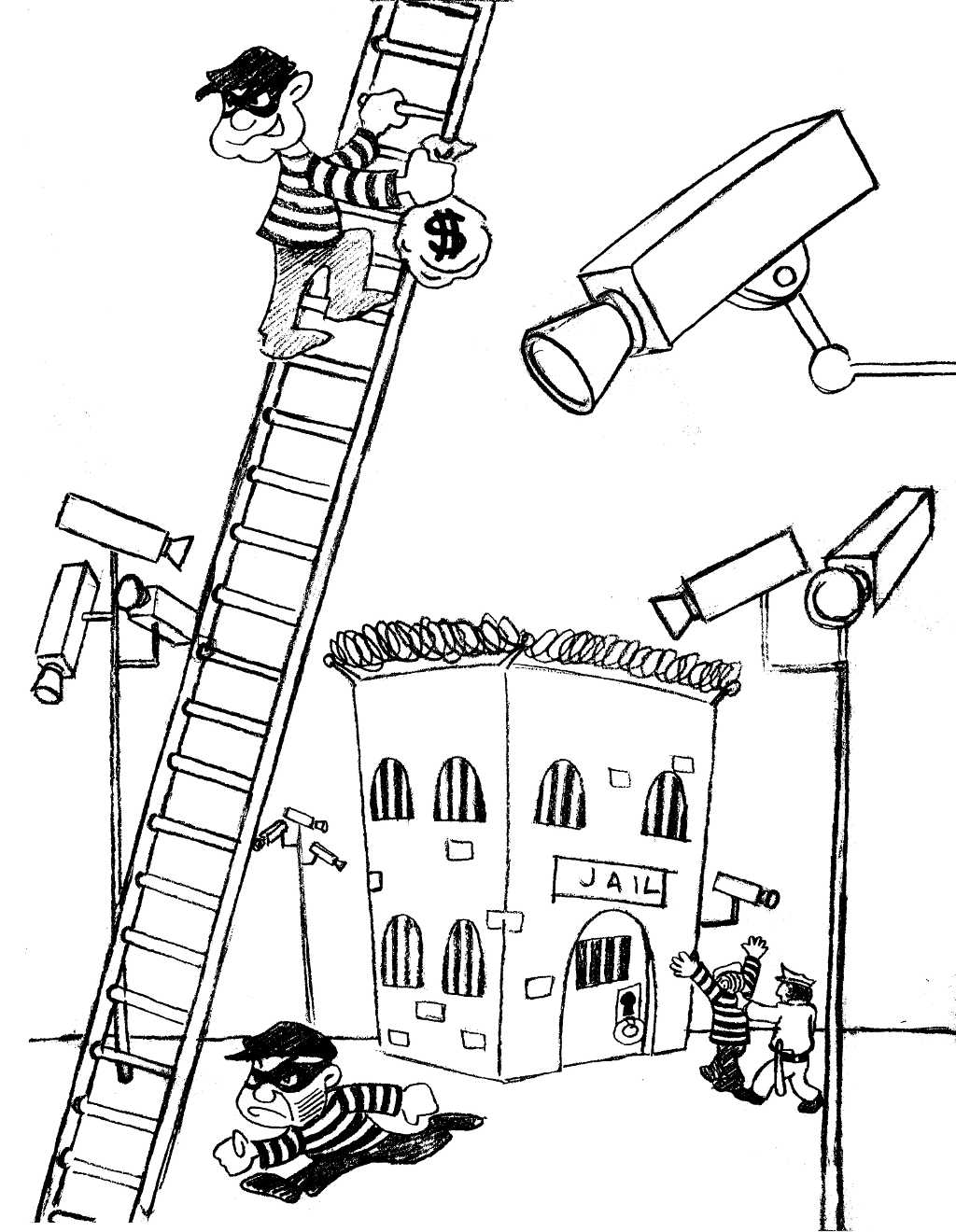
Surveillance may thus help facilitate corruption at higher levels of observation and information gathering. Of course to say generally that "surveillance causes corruption" would be an oversimplification, but surveillance does make it more difficult to commit petty crimes such as pick pocketing and shoplifting, while maintaining opportunities for police officers, shopkeepers, and others at the next-higher level of the social hierarchy to continue to commit crimes.
How does this actually work? It is not that unskilled street criminals suddely get a position as a high-ranking police officer. Rather, when surveillance cameras are installed throughout all the streets, street crime is reduced everywhere. Street thugs may be caught and sent to jail, or otherwise shut down, causing a shift in crime's "market equilibrium". For example, the increased effectiveness of law enforcement may create a vacuum in the marketplace for stolen goods. The demand for stolen goods remains, but the reduced supply can drive up the price of the stolen goods. This increased price of stolen goods may cause more Upward inhabitants to consider criminal activity, if the criminal activity is made more lucrative. Moreover, a new possibility of using (or temptation to use) the surveillance cameras for criminal purposes (e.g. police stalking potential victims) could be more tempting to certain members of law enforcement.
See for example, "Cleaner says she was stalked on CCTV by security guard" - News - Scotsman.com, Monday 14 March 2011 22:53. Here is a short quote from this article:
A SECURITY guard at one of Edinburgh's best-known visitor attractions used CCTV cameras to stalk a young female worker...This case raises some interesting issues, such as the conflict-of-interest in surveillance (e.g. CCTV footage mysteriously disappearing when under the control of police).
James Tuff used the camera system ... to track his victim and then radio her with lewd comments.
Tuff eventually sexually assaulted Dora Alves ... He was fined and placed on the sex offenders register for three years. ... She said: "At first it was just the odd comment about my body; he would say things about me having a real woman's body ... "But soon after he would appear out of nowhere when I was cleaning in the toilets. ... as she walked to the canteen on her break and stopped to collect something from her locker. "Mr Tuff came out of his office and grabbed me from behind. ... She said CCTV footage which could have proved the incident took place had gone missing.
Fruit-based analogy of surveillance-induced crimes
Let me propose an analogy that explains this phenomenon:The fruits of our labours exist within a market equilibrium. When goods are easily stolen, they exist like Low-Hanging Fruit (LHF), and if there were such LHF everywhere, its price would be relatively low.
But when some or most of this LHF is eliminated, thus reducing the supply of stolen "fruit", the demand for it may continue to exist. When the demand remains and the supply is reduced, the price escalates, creates new opportunities for crime in higher places or insider-trading in stolen fruit. And ladders are needed to reach the higher fruits, there exists both (1) an increased incentive for thieves to climb such ladders; and (2) an increased incentive for those already further up these ladders to consider the possibility of stealing these higher fruits, because of their increased value arising from the fruit shortages created by eliminating LHF.
There thus exists a possibility for surveillance to facilitate corruption, and there certainly have been some documented instances of this. Quantification of this effect remains a topic of future research on the practices of sousveillance of institutional agents.
Conflict-of-interest inherent in surveillance
Typically surveillance is done in secret, e.g. the video from surveillance cameras used or installed by police is not as freely and easily available to ordinary citizens as it is to the police.Moreover, there have been numerous documented cases of police destroying evidence that might incriminate them. The Tuff case above, where the CCTV footage disappeared, is not an isolated example. For example, in a case of mistaken identity, London police shot and killed Jean Charles de Menezes, a Brazilian electrician, and then lied about what happened ---- claiming he was running from them, when in fact he was just calmly walking and did nothing threatening. The police seized the hard drives from four separate surveillance systems in the area, and later reported that all four hard drives were blank, i.e. that no data was recorded by any of the surveillance cameras in the area. Despite the fact that no surveillance recordings in the area survived, the incident was captured by sousveillance (i.e. by citizens with camera phones in the area). http://en.wikipedia.org/wiki/Death_of_Jean_Charles_de_Menezes
Does police oversight cause high-level corruption?
Oversight committees may minimize this situation, i.e. where employees such as officers are watched by someone further up the ladder.Indeed, Foucault essentially asked "who watches the watcher?" (1995). Traditionally, oversight has been the immediate answer. But, more oversight only pushes the potential of corruption even higher up the proverbial ladder-of-life. Oversight can shift crime even further up this ladder, i.e. toward higher-level corruption (see below).
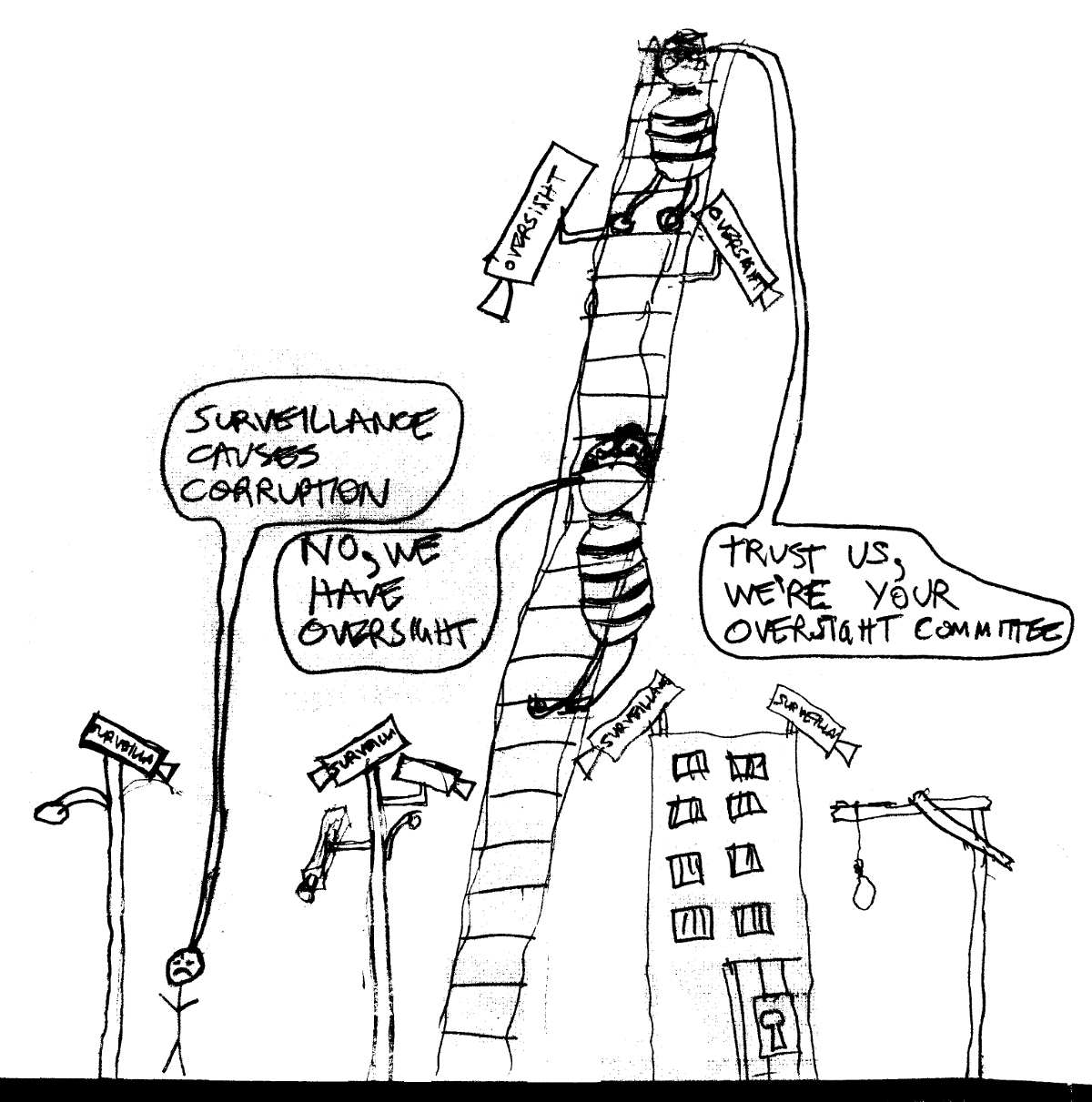
Foucault (1995) advocated an open society, where the mechanisms of control and surveillance are open and subject to pubic scrutiny. Ideally these would be part of a larger mechanism of "potence" that mediates the tension between undersight and oversight.
This is not to say that surveillance is the cause of corruption, or that oversight is the cause of high-level corruption, anymore than saying that installing cameras in the East end causes crime in the West end. But surveillance often does leave the door open to corruption. In some sense, surveillance is like locking only some of the doors to crime (e.g. the basement doors), while leaving the upper doors wide-open.
Moreover high-level oversight, such as congressional oversight investigating a corrupt Chief of Police, has the possibility, by the same means, push this high-level corruption even higher, up to the level of President or Prime minister (see below).
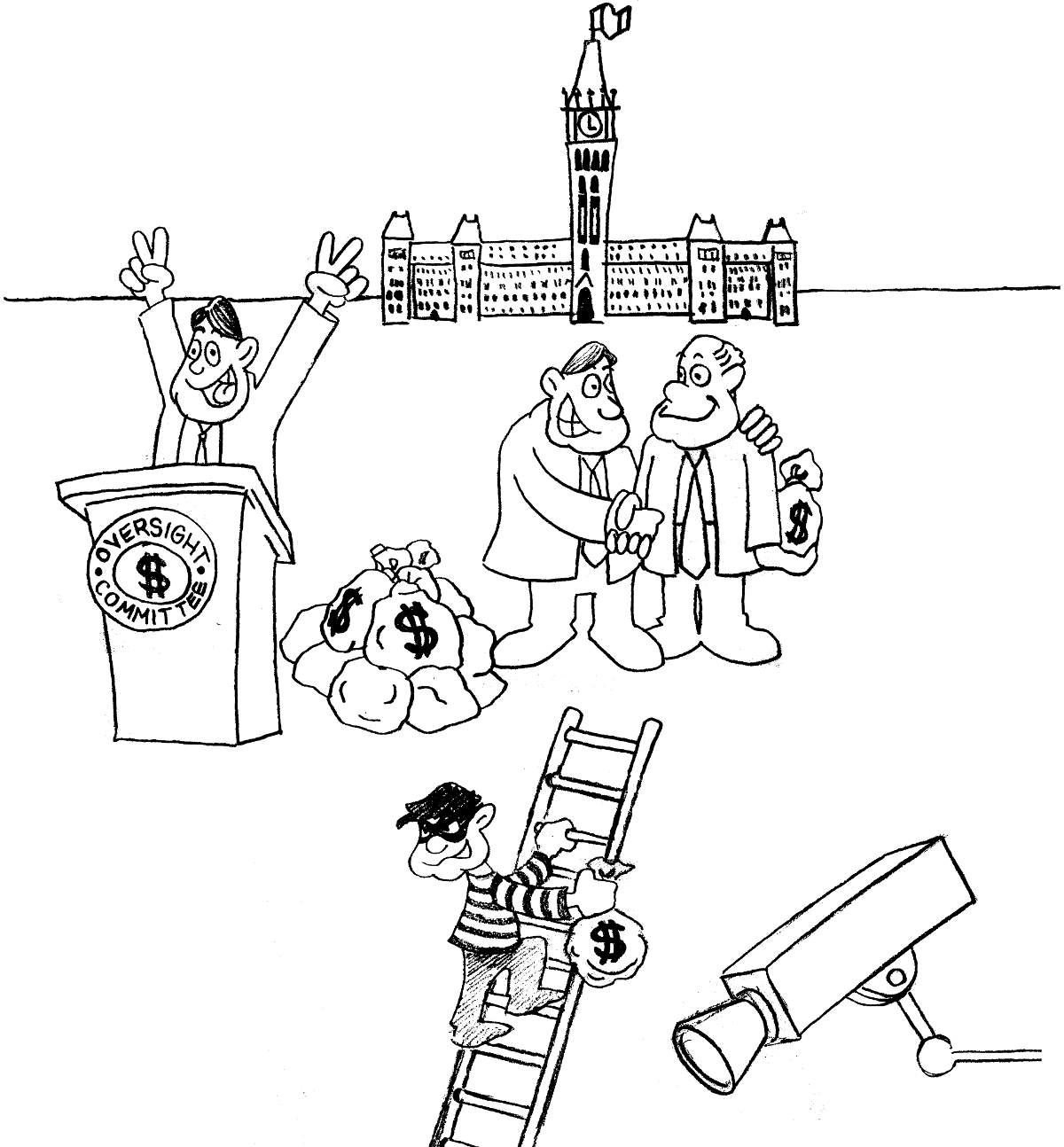
Of even greater concern is also the possibility that oversight may push crime and corruption to more unseen height obscured by the public eye. Indeed, massive investments in police infrastructure and police oversight may actually create a massively secret and powerful-yet-unaccountable force in society whose crimes are much more far-reaching than any low-level street crime.
Conclusions
Surveillance provides an incomplete picture that leaves room for corruption, and this incompleteness cannot be fixed with oversight alone.Sousveillance is inevitable and a necessary part of our sensory-world. Whether as a seeing aid, or a window into cyborgspace and Augmediated Reality, sousveillance is a natural part of seeing.
A society without sousveillance and undersight, i.e. a society with surveillance and oversight-only, may leave itself open to this Upward-migration of crime and corruption.
I summarize this reality as follows:
A society with oversight-only is an oversight on our part.
We need some way to guard against the possibility that surveillance may push crime up into the middle rungs of the "ladder of life", and that oversight may push crime up to the top rungs. A proposed solution to this problem is sousveillance, in particular, inverse-surveillance, as a way of balancing an otherwise one-sided "surveillance-only" society. Inverse surveillance might, for example, include citizens photographing police misconduct, shoppers photographing shopkeepers, and passengers photographing reckless cab drivers from within the very cab that might, for example, be involved in an automobile accident. This sort of information, taken from below, then communicated and spread through a social/media network can achieve a level of sousveillance-efficacy ("swollag") that may result in a change in policy. An important aspect of inverse surveillance is that it emanates from individuals recording their personal experience and their immediate vicinity, rather than the recording/monitoring of individuals by an outside party.
The upward-gaze of sousveillance (see below) provides a possibility of creating balance (equiveillance) between surveillance and sousveillance.
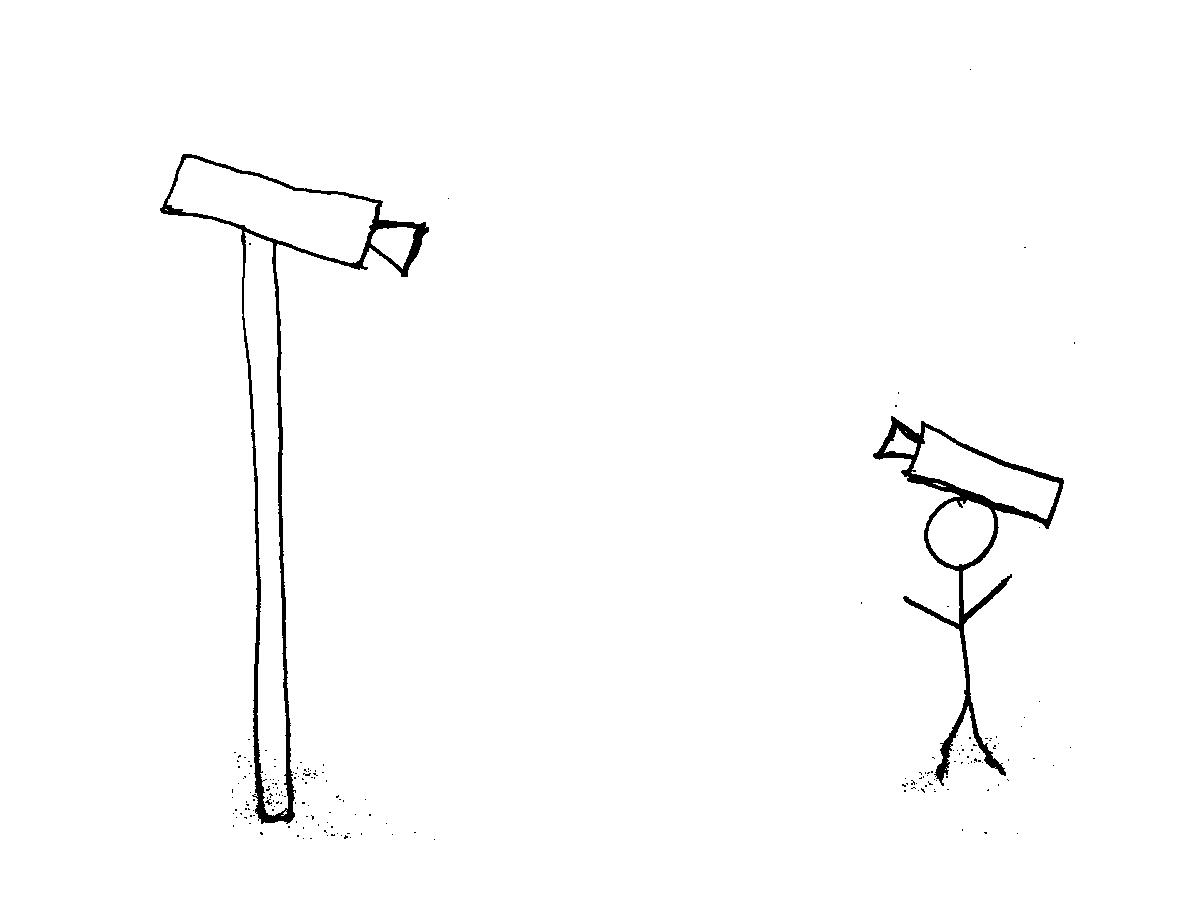
Placing those in the upper echelons of society over sousveillance potentially allows all persons, not just those down at street-level, to enjoy the benefits of a society with a more balanced "veillance".
Thus technologies like Augmediated Reality may itself restore sightlines in a plurality of directions, not just the one dictated by McVeillance.





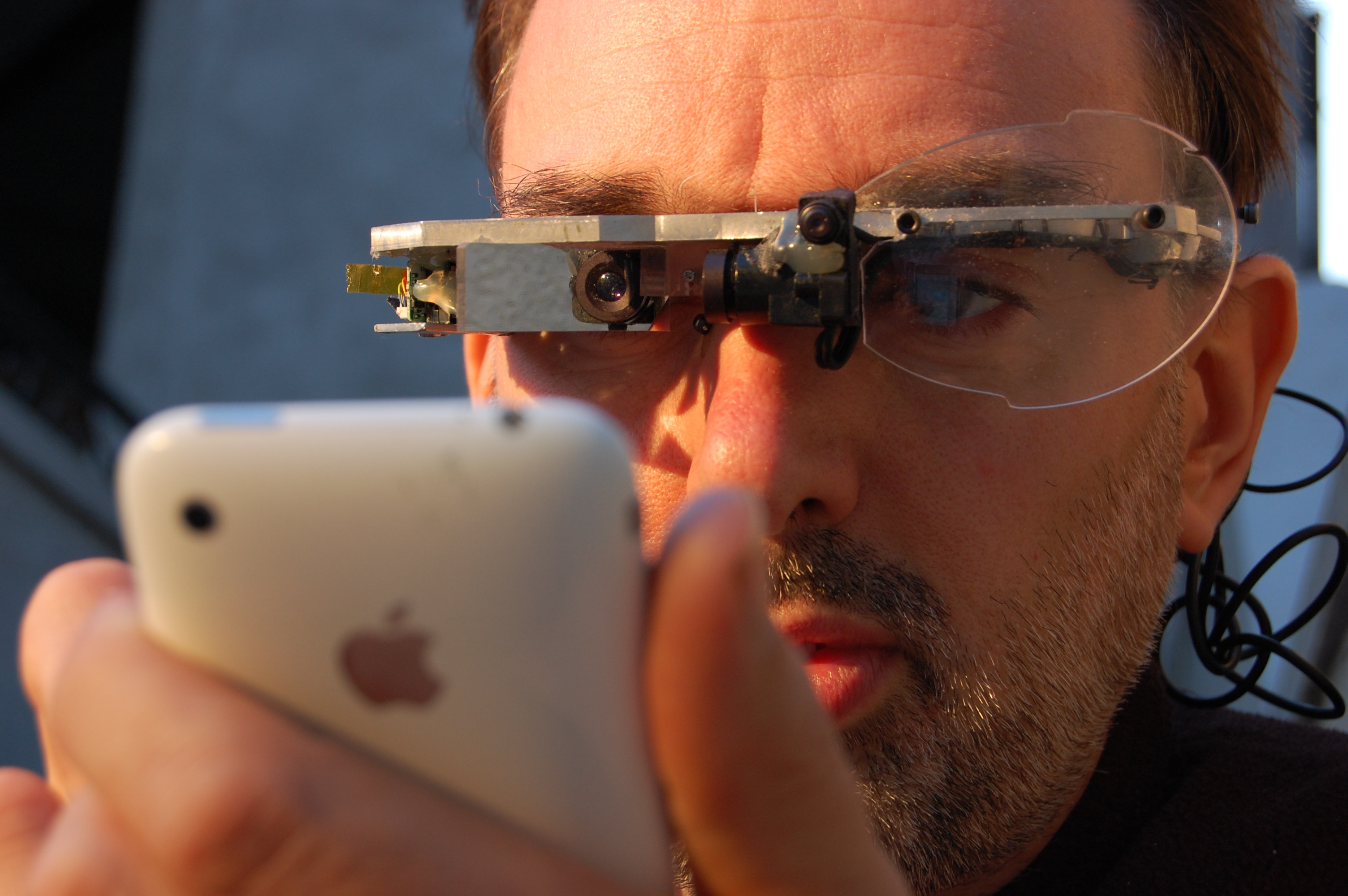
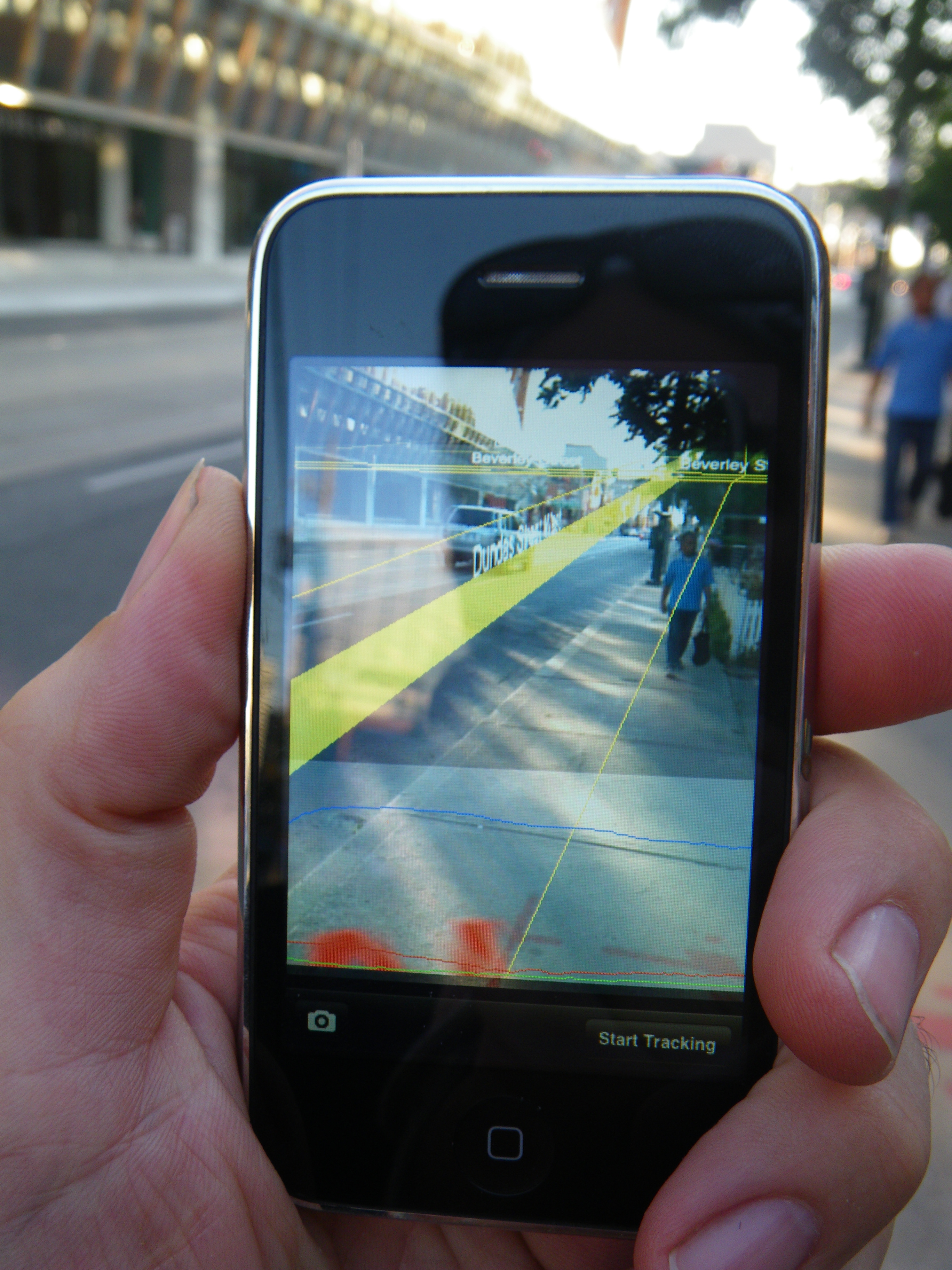

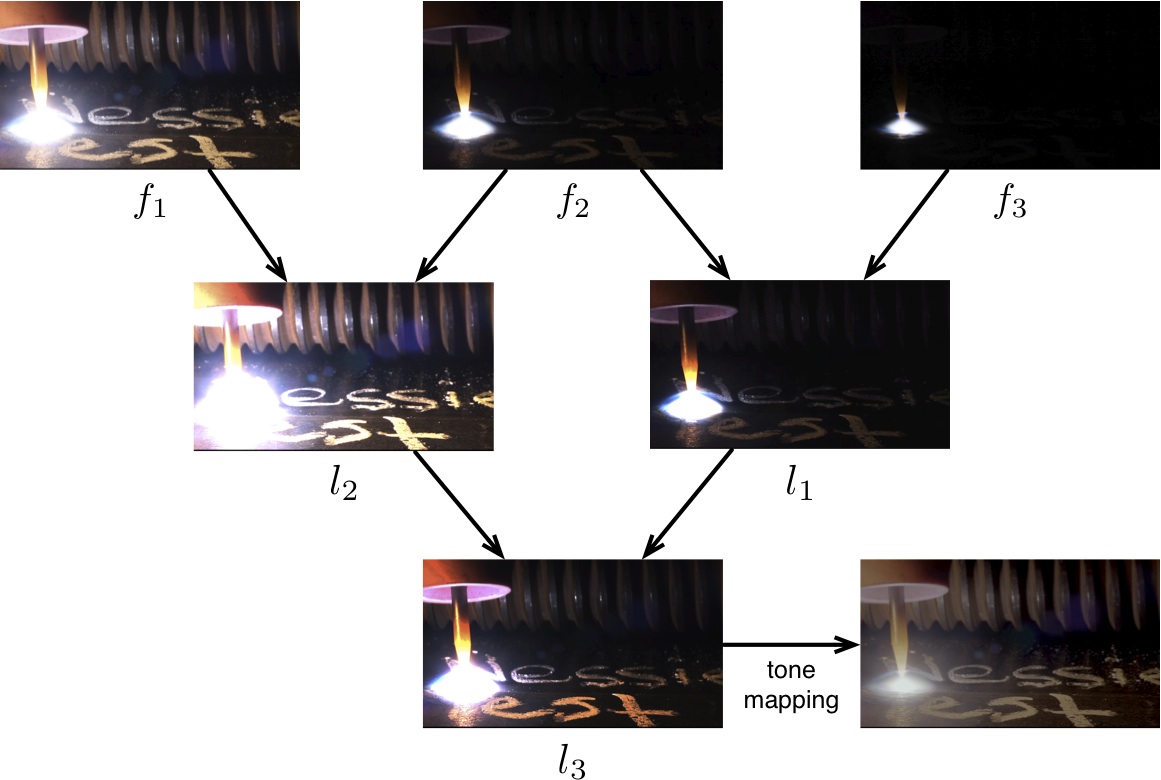
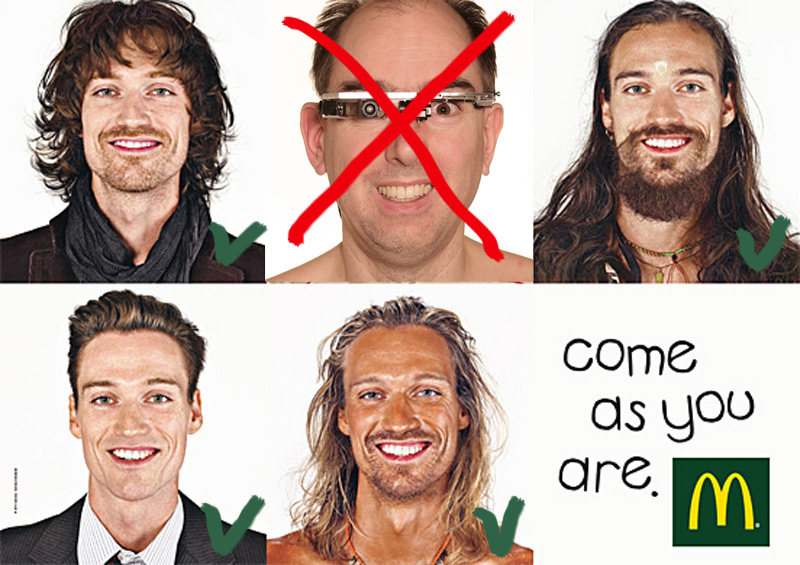

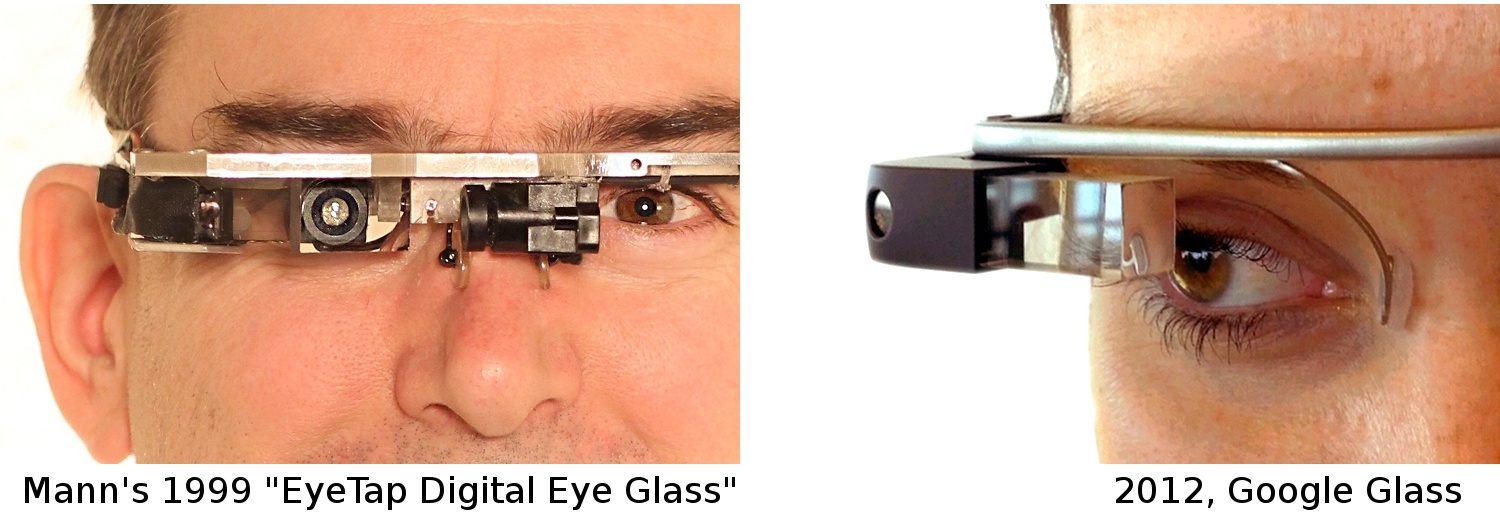
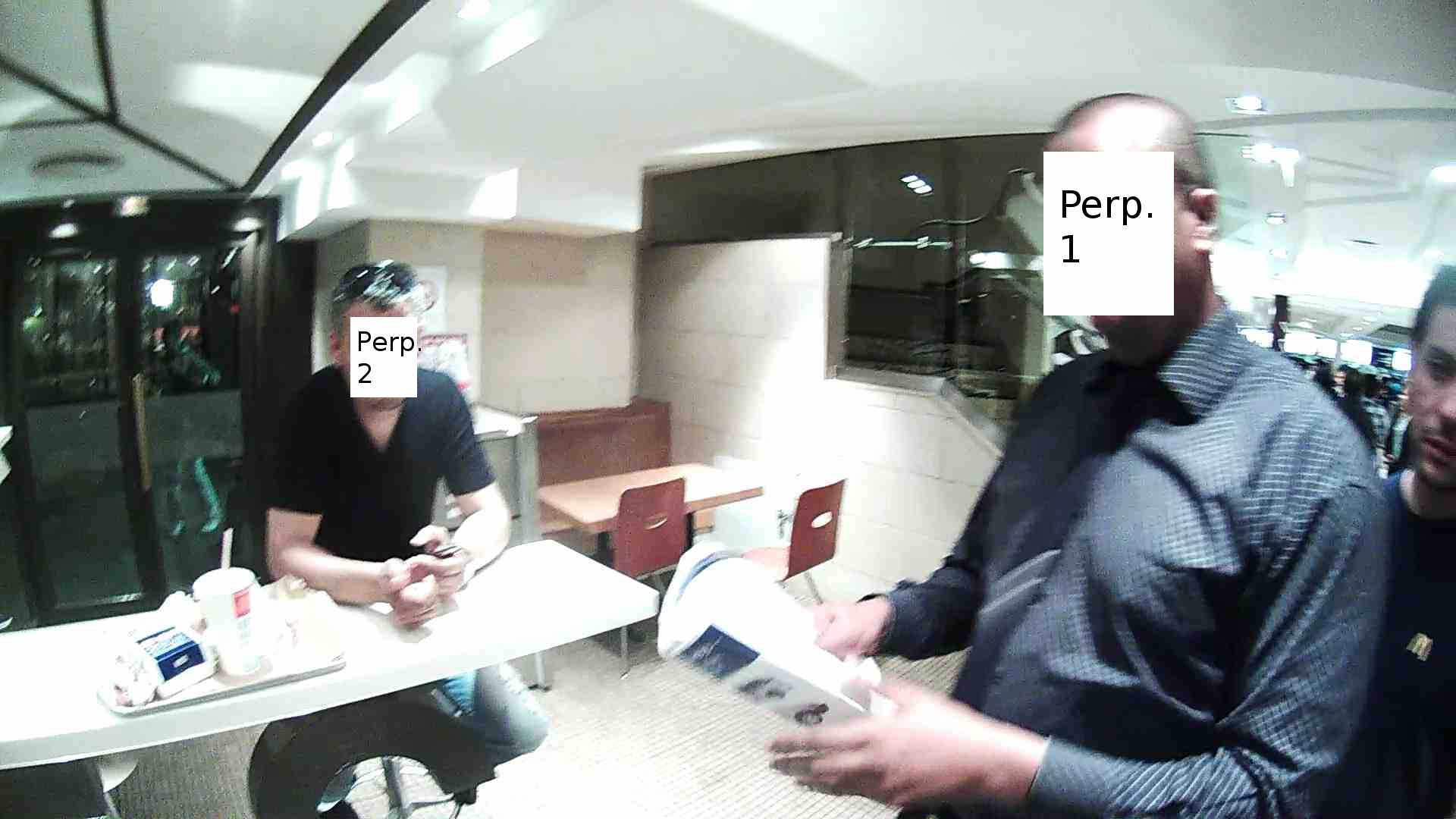 .
.
 .
.

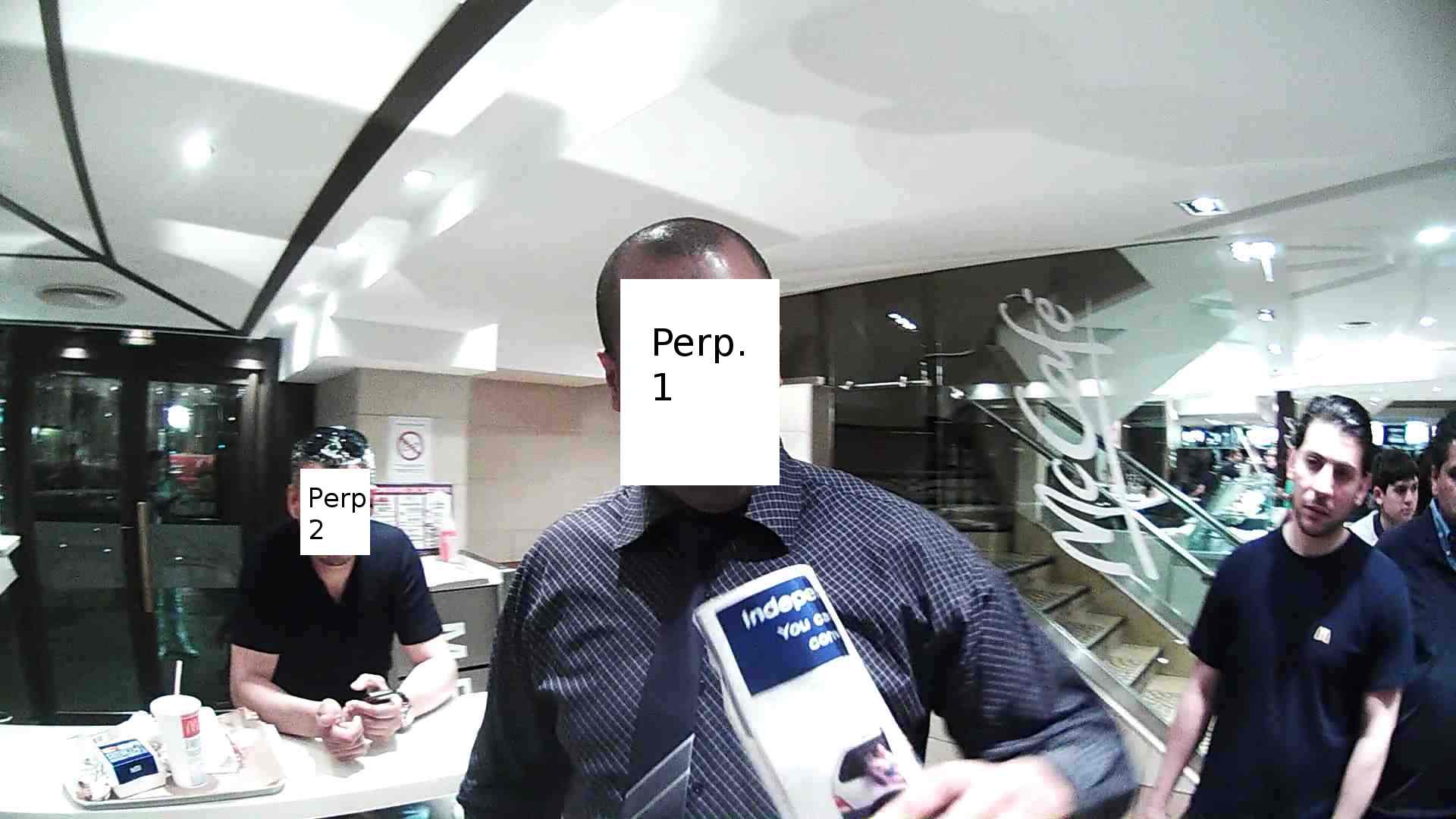
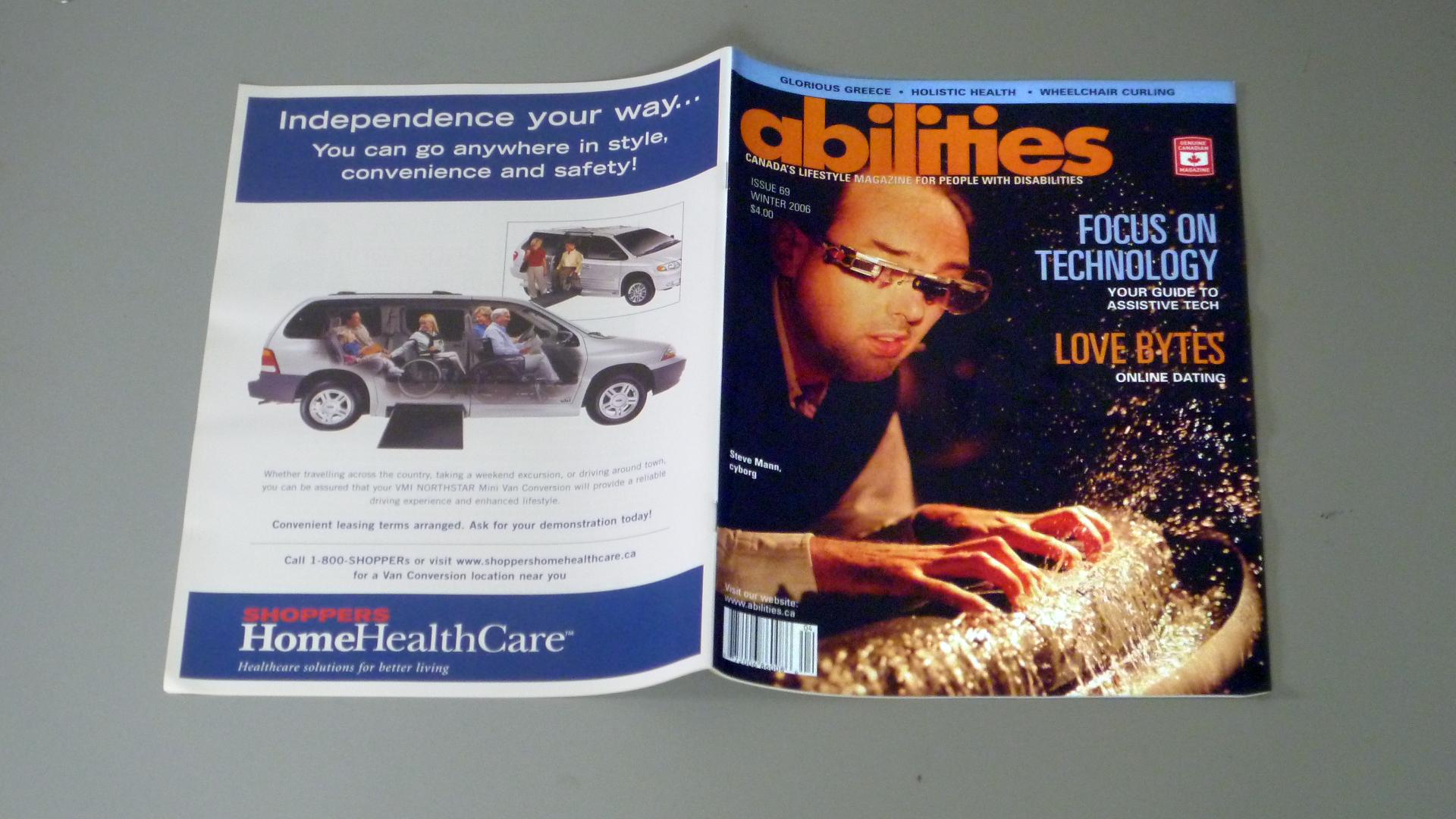 .
.


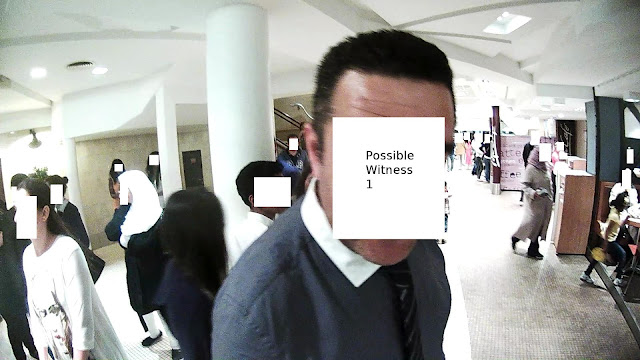
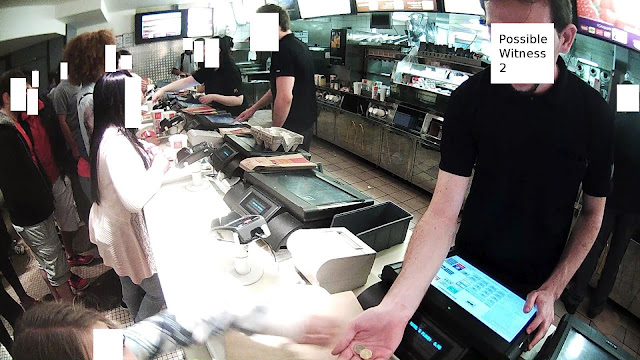

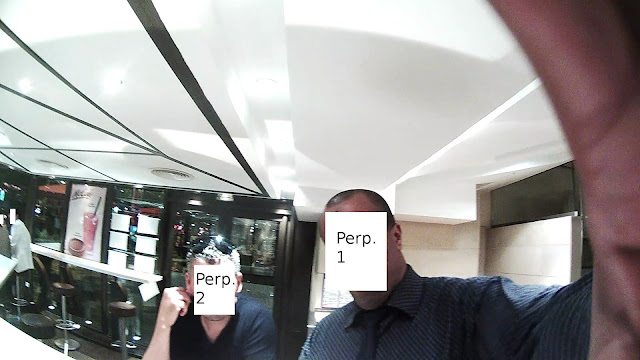




Add a comment